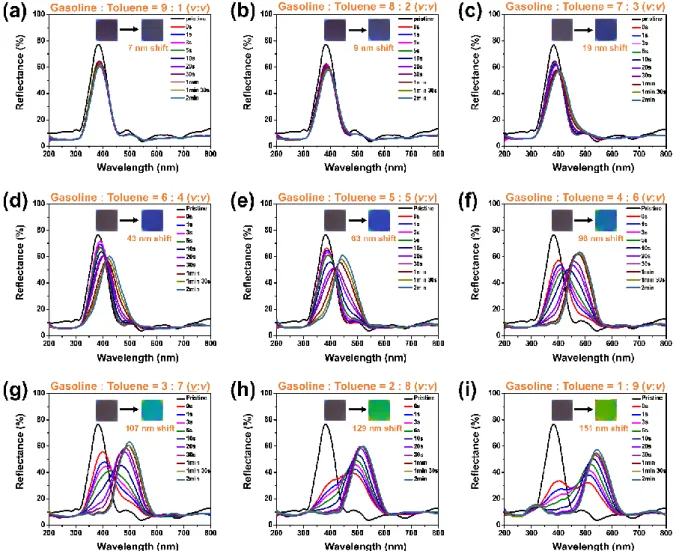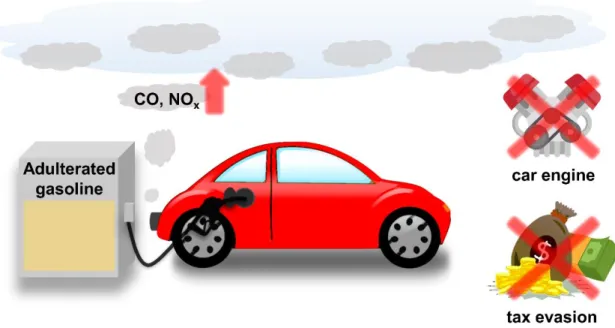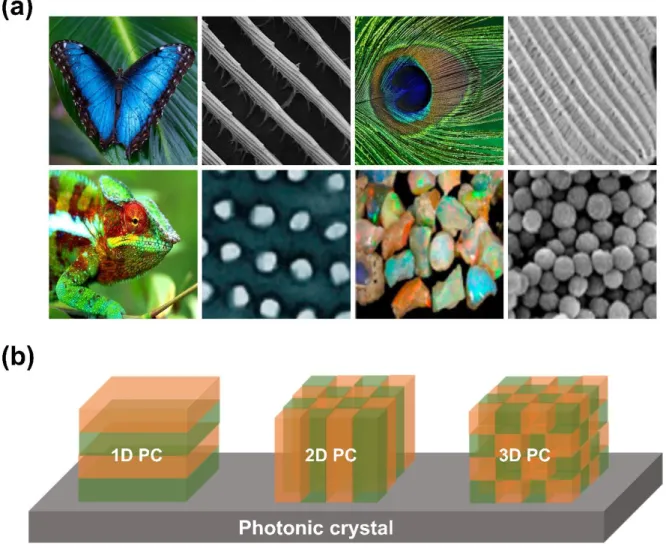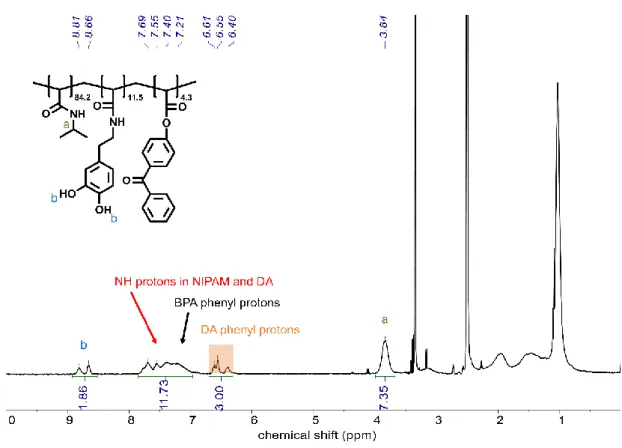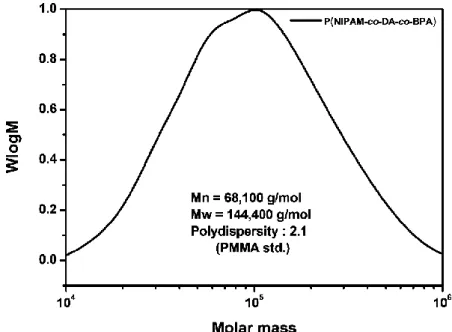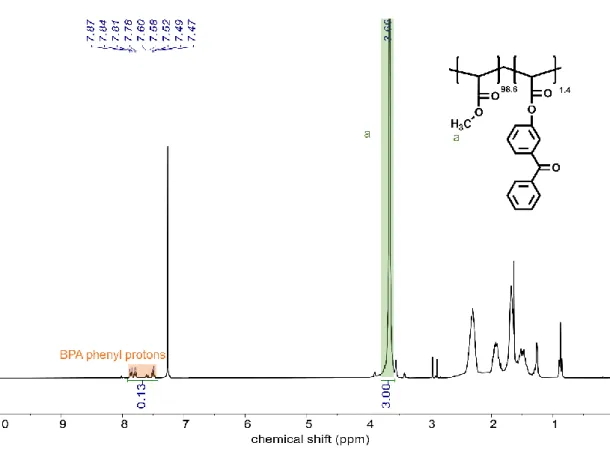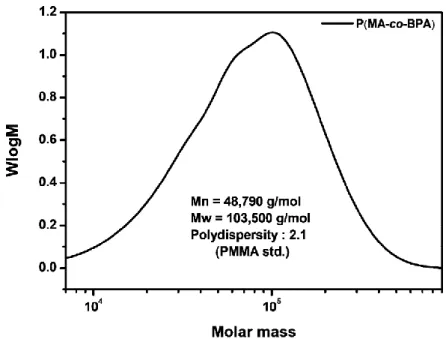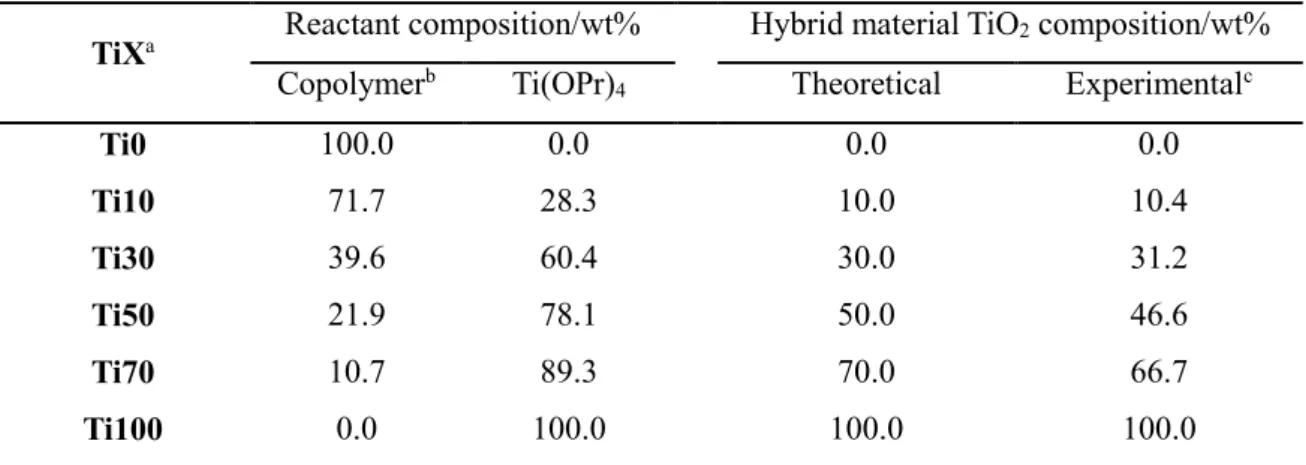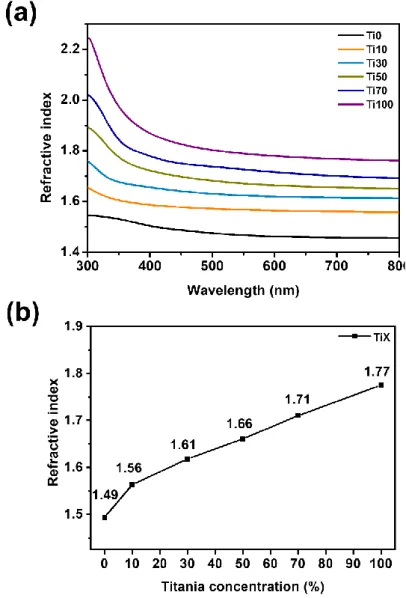Recently, the manufacture and distribution of adulterated gasoline mixed with pure commercial gasoline and adulteration has become a global problem. In this study, we propose highly reflective one-dimensional photonic crystals (1D PC) as a simple, in-situ detection method for adulterated gasoline with the naked eye. Then, they were used to fabricate a total of 11 layers of highly reflective Ti70/P(MA-co-BPA) 1D PC.
The prepared Ti70/P(MA-co-BPA) 1D PC showed pure purple and no color change was observed when immersed in pure commercial gasoline. Moreover, the excellent reusability of Ti70/P(MA-co-BPA) 1D PC was verified by 10 repetitions of swelling-deswelling tests. These results confirmed that the new Ti70/P(MA-co-BPA) 1D PC can be successfully applied to the on-site colorimetric detection of adulterated gasoline.
Figure 11] (a) 1D PC film fabrication by spin coating, (b) HRIM and LRIM were periodically cross-laminated for a total of 11 layers of 1D PC film. Figure 14] The appearance of a swollen film (a) when a Ti70/P(MA-co-BPA) 1D PC was immersed in pure commercial gasoline and (b) when immersed in adulterated gasoline. Figure 15] Image of color change with time when Ti70/P(MA-co-BPA) 1D PC was immersed in gasoline, methanol, xylene, toluene, and benzene.
Table 3] Refractive indices and thicknesses of HRIM and LRIM, the difference in refractive index between HRIM and LRIM, reflection in PSB of Ti0/P(MA-co-BPA), Ti50/P(MA-co-BPA) and Ti70 /P( MA-co-BPA) 1D PC.
Problems and status of adulterated gasoline use
Need for sensor development for detection of adulterated gasoline on-the-spot
Photonic crystals (PCs) are nanostructures composed of two materials with different refractive indices and made periodic along one direction.21-23 Figure 2 shows a schematic diagram that can be structurally divided into PCs that can be seen in nature. As shown in Figure 2a, it can be seen that the PCs have regular nanostructures such as blue morpho butterfly wings, peacock feathers, chameleon skin, and mine rock. PCs can be structurally divided into one-dimensional, two-dimensional and three-dimensional structures (Figure 2b).
Among them, 1D PC has the potential to be applied to various sensor fields because they are simpler, easier to manufacture and more responsive to stimuli than others.14. 1D PC is fabricated in periodic arrangements in the vertical direction of the surface using high refractive index material (HRIM) and low refractive index material (LRIM) with different refractive indices. Therefore, by periodically stacking colorless materials, a strong color (structural color) is obtained if the PSB is in the visible region of the spectrum, which can be seen with the naked eye.
The wavelength and reflection of PSB peak of 1D PC can be predicted using Bragg's law (Equation (1)) and Equation (2) respectively.24. The wavelength of the 1D PC's first maximum reflection (λmax) can be adjusted by changing the refractive index (n) and thickness (d) of HRIM and LRIM, respectively (Equation (1)).
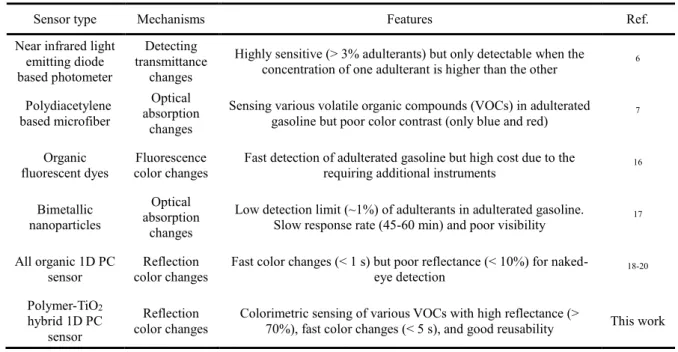
Development of novel polymer–TiO 2 hybrid material for highly reflective
Motivation
Since acrylate-based polymers show swelling behavior by various organic solvents, the development of the highly reflective 1D PC sensor that changes color by various organic solvents is expected when applied to a 1D PC sensor. In addition, the prepared HRIM and LRIM improved durability by incorporating a photo-crosslinking system, and the 1D PC sensor was expected to indicate excellent reusability.36. To verify the performance in adulterated gasoline of the 1D PC sensor prepared to meet expectations, immersion in single solvents (pure commercial gasoline, methanol, xylene, toluene, benzene), binary mixtures (gasoline/methanol, gasoline/toluene ), and ternary mixture (gasoline/toluene/methanol) investigated changes in optical properties, response time and reusability.
General
During sample preparation, the samples were coated with Pt and glassy C by sputtering to reduce potential damage to these samples due to the ion beam. The SEM instrument in the FEI Helios NanoLab 450 dual beam system measured cross-sectional SEM images of the samples.
Synthesis of materials
Dopamine acrylamide, DA
Poly(N-isopropyl acrylamide-co-dopamine acrylamide-co-4-benzoylphenyl
Poly(Methyl acrylate-co-4-benzoylphenyl acrylate), P(MA-co-BPA)
Preparation of P(NIPAM-co-DA-co-BPA) and TiO 2 hybrid (TiX) solutions
Synthesis of Ti70 and P(MA-co-BPA) dry gels
Swelling behavior analysis
Thin film fabrication
Assembly of the 1D PC sensor
Design concept of synthesized materials
Characterization of refractive index controllable TiX
The composition of the TiX reactant, the theoretical amount of the TiO2 hybrid material composition, and the experimental amount measured by TGA.
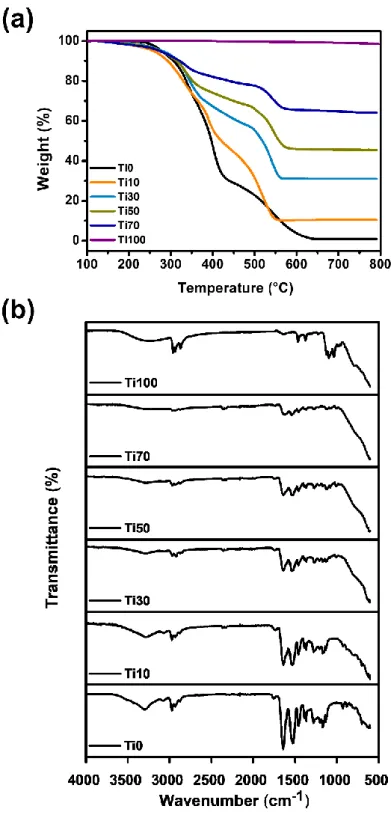
Fabrication of the 1D PC films
Refractive indices and thicknesses of HRIM and LRIM, difference in refractive index between HRIM and LRIM, reflectance in PSB of Ti0/P(MA-co-BPA), Ti50/P(MA-co-BPA) and Ti70/P( MA -co-BPA) PC 1D.
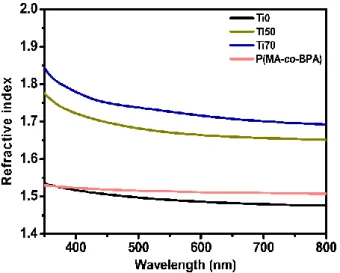
Exploring the color change and swelling behavior of Ti70/P(MA-co-BPA) 1D PC
Therefore, the reflectance of Ti70/P(MA-co-BPA) 1D PC decreased significantly with increasing extension of each layer. The reflectance and wavelength of Ti70/P(MA-co-BPA) 1D PC were almost the same as the initial values even after repeated swelling 10 times, confirming excellent reusability (Figure 16k). When Ti70/P(MA-co-BPA) 1D PC was swollen in benzene, the wavelength shifted a lot and the color change was obvious and quick to respond, so it was selected for the reusability test.
However, Ti70/P(MA-co-BPA) 1D PC showed equally good reusability in gasoline, methanol, xylene, and toluene. The color change of Ti70/P(MA-co-BPA) 1D PC can be interpreted by equation (4).54 The total solubility parameter (Hildebrand solubility parameter; δt) shown in equation (4) is defined as the square root of the binding density of energy, which is equal to the heat of vaporization of the compound divided by its molar volume (Vm). The solubility of a polymer depends on the difference between the δ value of the polymer and the δ value of the solvent.
Although P(MA-co-BPA) used in this study contained a small amount of BPA (1.3 mol%), it was assumed that the δ value of P(MA-co-BPA) was the same as the methyl acrylate polymer , ignoring the influence of BPA.52 As shown in Table 4, the δ differences (Δδp-s) between P(MA-co-BPA) and pure commercial gasoline, methanol, xylene, toluene and benzene were respectively and 0.7. In addition, the molar volumes (Vm) of methanol, xylene, toluene and benzene were respectively and 89.4 cm3/mol.55, 56 In Figure 17, P(MA-co-BPA) and Ti70 were made into gels and immersed in pure commercial gasoline, methanol, xylene, toluene and benzene, respectively, to obtain a swelling ratio (Equation (3)) by weights when sufficiently swollen and dried. In the order of xylene, toluene, and benzene, the swelling ratios of P(MA-co-BPA) gel.
and 2492%, respectively, with a trend according to Δδp, and in pure commercial gasoline, the swelling ratio of the P(MA-co-BPA) gel was 22% (Figure 17a).33, 57 However, in methanol, swelling ratio of the P(MA-co-BPA) gel demonstrated a relatively large swelling ratio (327%) despite relatively large Δδp-s compared to other solvents. As shown in Figure 17a, it was observed that P(MA-co-BPA) turned white when immersed in methanol, indicating that methanol was a non-solvent for P(MA-co-BPA). This abnormal swelling behavior appears to be due to the concentration-dependent diffusion of methanol into the interconnected network of P(MA-co-BPA).58, 59 As shown in Figure 17b, when the Ti70 gel was immersed in gasoline pure commercial. , methanol, xylene, toluene, and benzene, the swelling ratios of the Ti70 gel were 41%, respectively, and it was confirmed that there is no difference in the swelling ratio between the dry gel and the P(MA-co-BPA) gel.
As a result, when Ti70/P(MA-co-BPA) 1D PC was immersed in pure commercial gasoline, the thickness of P(MA-co-BPA) layer almost changed, but impurities such as methanol, xylene, toluene and of benzene added to adulterated gasoline, the thickness of the P(MA-co-BPA) layer increased significantly due to swelling, which can be detected by the color change of 1D PC. Appearance of the swollen film (a) when Ti70/P(MA-co-BPA) 1D PC was immersed in pure commercial gasoline and (b) when it was immersed in adulterated gasoline. Image of color change with time when Ti70/P(MA-co-BPA) 1D PC was immersed in gasoline, methanol, xylene, toluene, and benzene.
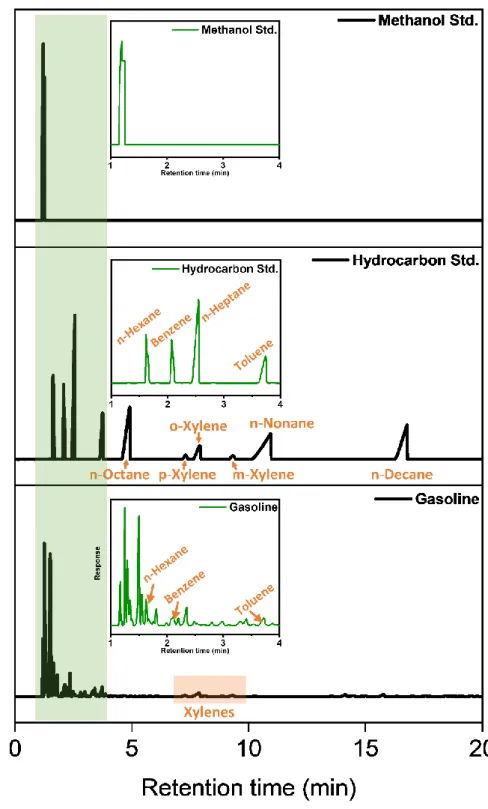
Application of Ti70/P(MA-co-BPA) 1D PC
This is because, as observed in the GM mixture, methanol induces about 65 nm red shifts in Ti70/P(MA-co-BPA) 1D PC regardless of the volume ratio. In addition, as the volume ratio of toluene in the GTM mixture increased, a decrease in the reflectance of Ti70/P(MA-co-BPA) 1D PC was observed. It was previously confirmed that methanol does not break the periodicity of Ti70/P(MA-co-BPA) 1D PC.
Therefore, this result can be interpreted as the swelling of the P(MA-co-BPA) layers, which increased as the volume ratio of toluene to the GTM mixture broke the structural periodicity of Ti70/P(MA-co-BPA) 1D pc or created a defect. As a result, it was confirmed that adulterated gasoline containing toluene and methanol can be detected visually colorimetrically using Ti70/P(MA-co-BPA) 1D PC. In addition, the shape of Ti70/P(MA-co-BPA) 1D PC can be easily changed by various shaping methods such as physical cutting and UV etching using a photomask.
As a simple example, a crown-shaped mask was attached to Ti70/P(MA-co-BPA) 1D PC and used for visual detection of adulterated gasoline. As a result, it was confirmed that although Ti70/P(MA-co-BPA) 1D PC cannot selectively detect only certain substances among impurities in adulterated gasoline, it can sensitively detect all impurities. Through this study, a high-reflectance 1D PC sensor (Ti70/P(MA-co-BPA) 1D PC) was fabricated that can colorimetrically detect pure commercial gasoline and adulterated gasoline mixed with impurities such as toluene and methanol.
Ti70/P(MA-co-BPA) 1D PC showed a purple reflective color in the pristine state and no color change was observed when immersed in pure commercial gasoline. However, the color of Ti70/P(MA-co-BPA) 1D PC rapidly changed to strong blue, blue, yellow-green, and orange within 10 s when immersed in methanol, xylene, toluene, and benzene, respectively, and also became blue and yellow-green when immersed in adulterated gasoline mixed with toluene and methanol. Based on these results, it was confirmed that the developed Ti70/P(MA-co-BPA) 1D PC can successfully detect adulterated gasoline in situ.
Although the visual detection characteristics of Ti70/P(MA-co-BPA) 1D computer adulterated gasoline were evaluated using only a few model solvents, it is assumed that it can be sufficiently applied to the detection of a wider variety of adulterations considering excellent solvent swelling characteristics of the P(MA-co-BPA) layer. In conclusion, the results of this study are expected to be the basis for the development of a simple and reliable PC 1D sensor that can detect various analytes. Practical determination of solubility parameters of 1-alkyl-3-methylimidazolium bromide ([CnC1im] Br, n ionic liquids by inverse gas chromatography and Hansen solubility parameter.
